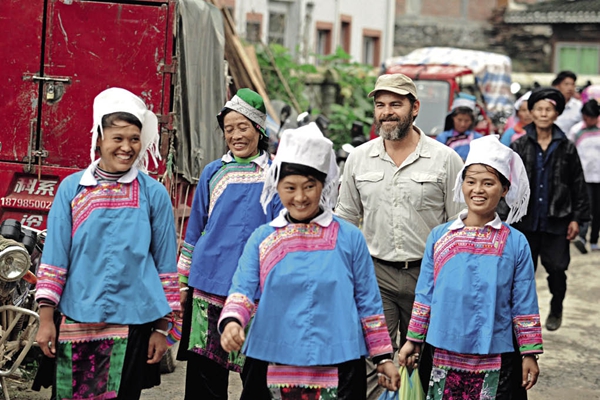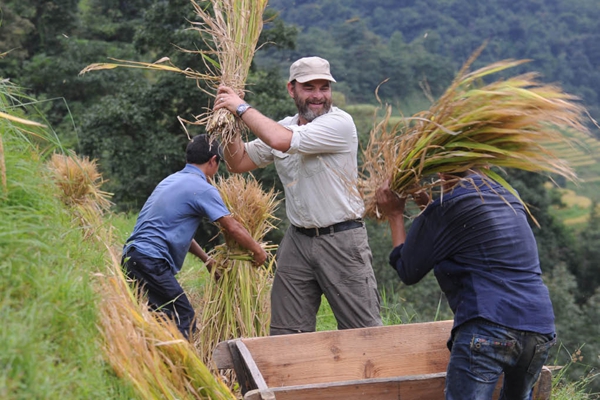By ZHANG XIN
By ZHANG XIN
ON April 12, 2016, Meeting at Unknown Places: Guizhou was first broadcast on France 2 and became the highest-rated of all the programs shown on that night. The documentary gave 5.23 million French viewers a glimpse of the old, mysterious, rustic, and beautiful scenes of the Miao stockade village in Guizhou. The Miao are one of the 56 ethnic groups in China and mainly live in the southwest province of Guizhou. The stockade village is where the Miao people have lived for thousands of years.

Life is harmonious in the remote Miao stockade village. Photos courtesy of Meeting at Unknown Places.
Meeting at Unknown Places presents local customs and practices of countries all over the world to Francophone viewers. The series was launched in 2006, and this particular episode was the first one filmed in China.
China Mandatory
Preparation for the stockade village episode began more than two years ago. Its head writer, Franck Desplanques, said, “In the globalized world we live in today, we couldn’t miss out China.”
In each episode of the program, the anchor, Frédéric Lopez, invites a celebrity guest to accompany him to an unknown place and live with the locals. They talk about the philosophies adopted by the people living in remote and difficult circumstances, inspiring modern viewers to think about the world in a different way. The design of the program is original: Guests have no idea of their destination before boarding the plane, so the feelings they reveal in the “unknown place” they arrive at are authentic. The production group of Meeting at Unknown Places: Guizhou had a connecting flight in Shanghai, got on a transfer bus in Guiyang, capital of Guizhou, and then walked for two hours before they finally arrived at their destination, the Yangkai Miao stockade village of Rongjiang County in Guizhou.

Colovis Cornillac works in the farmland with his host family.
The guest of this episode was the French movie star Colovis Cornillac. It was his first time in China. When he found out he was going to the Middle Kingdom, Cornillac, who claimed to be the type of person who “did not easily reveal his emotions” jumped for joy! “I’ve always dreamed of going to China!” he said.
After a short stop-over in Shanghai, Frédéric Lopez and Colovis Cornillac took a hilly road “to the middle of nowhere” to await their hosts. Three villagers, Long Laoniu and his wife Zhu Laopu, and their relative Meng Laohao, appeared with warm smiles. Cornillac’s initial anxiety disappeared in an instant. As they walked to their destination, Cornillac and the viewers’ hearts were captured by the beautiful mountainous sceneries. The production group spared no expense, filming swooping aerial scenes and creating a strong contrast between the magnificent natural sights of Guizhou and the bustling metropolis of Shanghai, thus presenting a picture of the pluralistic and real China.
For the next two weeks, Lopez and Cornillac lived together with this Miao family – the husband Long Laoniu is shrewd and realistic, his wife Zhu Laopu enthusiastic and kind, and the hard-working and humorous Meng Laohao is a relative who lodges at their house. The documentary was filmed at the beginning of September 2015, which is the busy farming season for locals, who work from dawn to dusk. The guests also threw themselves into the farm work on the mountains with the hosts. They caught fish in the river, chopped pig feed and brewed rice wine together.
The communication between the host family and the French guests was slow to develop. At the beginning, they only extended simple greetings. Gradually, they let down their defenses and opened their hearts to each other. By the end they had gained an in-depth picture of each other’s life stories.
When Cornillac was asked about his job, he said that his job was of no use here, and that he was only “trying to make people think.” The lodger Meng Laohao didn’t know Cornillac was an actor, and responded, “You cannot say it’s useless; it’s very important to make people think.”
Challenging Traditional Impressions
“This was the first time I had been to China. I think more things should be done to challenge French people’s stereotype of China,” the head writer of Meeting at Unknown Places Franck Desplanques said in an interview. “We added the scene of a modern metropolis, Shanghai, to our program for the first time in order to embody the pluralism of Chinese society.” He added that the previous episodes all went straight to the destinations with harsh living conditions, but this time as they shot in China, the scenes of Shanghai were added to present the real and contemporary China to French viewers.

The Miao are one of the 56 ethnic groups in China, and mainly live in the southwest province of Guizhou.
“The Miao stockade village was the most ‘modern’ place we went to since we launched our program,” Franck Desplanques said. The Miao stockade village was the same as other destinations in that the participants needed to walk for hours to reach the “unknown place,” but it was the only one that had access to tap water and electricity. The close-up shot of the electric stove at dinner on the first day tells viewers that this is a village with electricity. Then the one of the water faucet outdoors tells viewers this is a village with water. The anchor, Frédéric Lopez, asked the villagers to recall their feelings 12 years ago when the village first gained access to electricity, demonstrating the process of rural modernization in China. The documentary also briefly introduced the history and residents of the Miao stockade villages, as well as the traditional farming method of the co-existence of fish and rice, hybrid rice farming, and the family planning policy, which are characteristic of China.
The music, full of artistic expression, burnishes this episode. There are folk music, symphonies, and electronic music in Meeting at Unknown Places: Guizhou, which are sometimes independent and sometimes integrated. The music highlights the theme of the program, conveying its humanity in a more appealing way.
Genuine Communication Touches the Heart
Huang Yingxue, interpreter of the production group, said that, as the villagers couldn’t speak Mandarin Chinese, they needed another interpreter to translate the Miao dialect into Mandarin. But there was a third, unspoken language. Cornillac recalled, “I looked at them all the time and they looked straight back at me. We had real eye communication. If I were asked to close my eyes and recall this journey, what appears first in my mind is the beautiful smiles of my hosts.” He added: “The humanity of the Miao stockade village is unforgettable to me. The villagers love their life and attach great importance to education, which presents a harmonious and vigorous village to me.”
Cornillac, a tough guy on the screen, said an emotional farewell to China. The solidarity and friendliness among the villagers of the Miao stockade village left a deep impression. “No one will ever starve in this village,” he told Frédéric Lopez. When they were about to depart, he told the three villagers, “I will miss you.” He also told his hostess Zhu Laopu, “You have the most beautiful smile in the world.”
Cornillac told our reporter, “I’ve never had the chance to be in China or to work with Chinese teams. In fact, I would love to meet Chinese viewers and share my films with them. This has been added to my to-do list,” he said. “This journey will influence my whole life. I can’t pinpoint exactly how, but one thing is certain, it has brought happiness into my life.”
“If people come with kindness, then they will find out that China is great,” Chinese Ambassador to France Zhai Jun said at the premiere of Meeting at Unknown Places: Guizhou. “Amity between people holds the key to sound relations between states. I hope that in the future, the communication between China and France will be more mindful because I believe exchange and communication of the mind are the most important forms.”
Zhai Jun said that China had already surpassed the U.S. to become the biggest overseas market for French movies. Last year, the Chinese viewers of French movies reached 15 million person-times and it now stands a far better chance of further growth in the future.
ZHANG XIN is a reporter from the European Times.